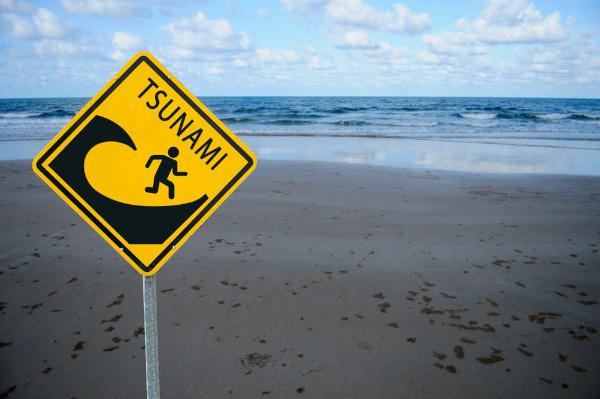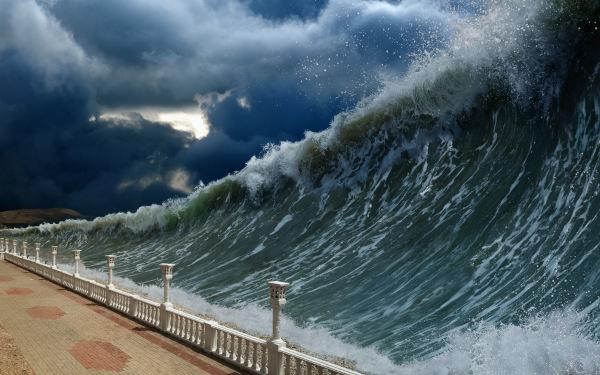Tsunami in Brazil: possibility or legend? There is an intense debate about the possibility of occurrence of tsunamis in Brazil. You tsunamis are mainly caused by strong earthquakes with an epicenter at the bottom of the oceans, and, as we know, the Brazil it is located in the center of a tectonic plate, far from areas of great geological instability.
Despite this, a British study indicates that a strong eruption of the volcano Cumbre Vieja, in the Canary Islands, could trigger giant waves that would reach the North and Northeast regions. The theory, however, is not unanimous among researchers.
Read too: Why is the United States so hit by hurricanes and tornadoes?
Causes of a Tsunami
Tsunamis can be defined as giant waves, which can vary from 10 m to 30 m in height on average, generated as a result of a great disturbance in the ocean waters.
His training is mainly through intense earthquakes that they can occursr on the ocean floor. The tremors, in turn, originate in areas where there is tectonic instability, such as the boundary between two or more plates. These events release a large amount of energy, which in turn causes immense volumes of water to be displaced.
As earthquakes, volcanic activities on the ocean floor or in coastal areas can cause tsunamis. In the second case, the movement takes place by the spillage of a significant volume of materials resulting from the volcanism in the waters. External factors can also be responsible for giant waves, such as falling meteorites and large explosions carried out in the marine environment.
After all, what are the chances of a phenomenon like this reaching the Brazilian coast?

Is it possible to have a tsunami in Brazil?
the giant waves are more common in areas of tectonic instability. Most of the worst tsunamis in history occurred in countries bathed by the Opacific ocean. The waves were consequences of intense earthquakes of magnitude greater than seven degrees in the Richter scale, with an epicenter close to the coast.
Brazil is located at the center of the South American Plate, which indicates a relatively comfortable position with respect to high intensity seismic shocks, capable of triggering tsunamis. The country, however, is not free from the occurrence of earthquakes.
Some researchers believe that there is, indeed, the possibility of the Brazilian coast being hit by a tsunami in the future. Its origin, however, would be thousands of kilometers from the coast of the country, more precisely near the northwest coast of the African continent.
A British study found that athe eruption of the Cumbre Vieja volcano could trigger tidal waves that would propagate through the Atlantic and would reach countries of the American continent, including Brazil.

This volcano is located in La Palma, an island belonging to the Canary Islands archipelago, northwest of Africa. THE eruption would cause one of its flanks to collapse (side wall), dumping huge volumes of debris, like rocks and earth, in the ocean. This addition of material and the resulting agitation in the waters would be responsible for waves of great proportions, which would arrive close to coastal areas, with a height between 15 m and 40 m.
The theory, however, is not unanimous among those who research the theme. The last eruptions of the Cumbre Vieja were in 1949 and 1971, and although there were landslides, no abnormal movement was recorded.
Therefore, the chances of Brazil being hit by a great tsunami are negligible, practically nil.
See too: What is a tidal wave?
Consequences of a tsunami in Brazil

Thinking about potential events like a strong eruption of Cumbre Vieja, the cities of North and Northeast of Brazil would be the main affected, with damage that would extend from the Amapá.
The violent entry of water and its advance through the territory, which can be hundreds of meters to kilometers, would provokem the destruction of the lowered areas nearby dthe coast and floods in the most distant cities. Depending on the energy that caused the movement, the waves can propagate along the entire coast of the country.
Recently, a survey by the State University of Rio de Janeiro (UERJ) revealed that the tsunami that devastated Lisbon and reached other countries near the Iberian Peninsula, in 1755, reverberated across the Atlantic and Arrived to North East of Brazil.
Evidence shows that the waves also reached the R1st of January. The biggest wave reached almost two meters in height, and, in certain areas, the waters penetrated four kilometers. In the city of Tamandaré, in Pernambuco, the flood rose to 800 meters.
Prior to this event, waves from to eight meters flooded the then captaincy of São Vicente, on the coast of São Paulo, in 1541. The waters caused the destruction of buildings, but it is not known for sure what triggered this so-called localized tsunami |1|. It is believed that its causes were related to meteorological issues.
Other (few) events were registered on the Brazilian coast, in which medium intensity earthquakes caused tsunamis and floods in specific cities. The effects, however, are not the same as those experienced by areas hit by tsunamis.
Note
|1| VELOSO, José Alberto Vivas. Tsunamis in Brazil. USP Magazine, [S.l.], n. 91, 2011, p. 40-55. Available in:. Accessed on March 18th. 2021.
By Paloma Guitarrara
Geography teacher
Source: Brazil School - https://brasilescola.uol.com.br/geografia/tsunamis-no-brasil-possibilidade-ou-lenda.htm

